Sudoku Puzzle #47
by: Dan LeKander
This holiday Sudoku Puzzle will warm your heart and take your mind off any inclement weather. So grab a hot cup of coffee or tea & tackle this very difficult puzzle with your knowledge of advanced Sudoku techniques.
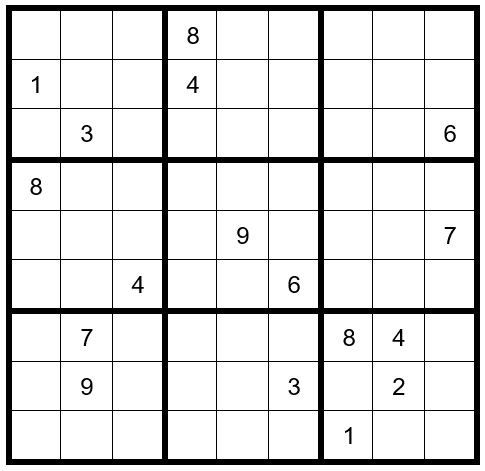
DAN’S 8-STEP APPROACH TO SOLVING ALL SUDOKU PUZZLES
Once you have completed the puzzle, to the extent that you have filled-in all obvious answers and have written all potential options across the top of the unsolved cells (PUZZLE PREPARATION), Dan recommends the following Steps to complete the puzzle.
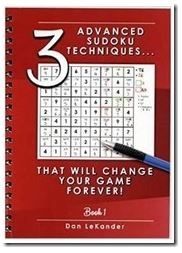
Step 1: Sudoku Pairs, Triplets and Quads – September 2015
Step 2: Turbos & Interaction – October 2015
Step 3: Sudoku Gordonian Rectangles and Polygons – November 2015
Step 4: XY-Wings & XYZ Wings – December 2015
Step 5: X-Wings – January 2016
Step 6: DAN’S YES/NO CHALLENGE
Step 7: DAN’S CLOSE RELATIONSHIP CHALLENGE
Step 8: AN EXPANSION OF STEP 7
Steps 1-5 are relatively common techniques and are explained in the TI LIFE articles above. Steps 6-8 are covered in detail, in Dan’s book.
Also, see Sudoku Puzzle Challenge… February 2016, March 2016, April 2016, May 2016, June 2016, July 2016, August 2016, September 2016, October 2016, November 2016, December 2016, January 2017, February 2017, March 2017 , April 2017, May 2017, June 2017, July 2017, August 2017, September 2017, October 2017 , November 2017 , December 2017, January 2018, February 2018, March 2018, April 2018. May 2018, June 2018, July 2018, August 2018, September 2018 , October 2018 and November 2018.
As a reminder, the basic rules of Sudoku are that the numbers 1-9 must be contained and cannot be repeated in a row, column, or box, and there can only be one solution to the puzzle.
PUZZLE PREPARATION
Prior to utilizing techniques first complete the 4 Steps of Puzzle Preparation …
- FILL IN OBVIOUS ANSWERS
- FILL IN NOT-SO-OBVIOUS ANSWERS
- MARK UNSOLVED CELLS WITH OPTIONS THAT CANNOT EXIST IN THOSE CELLS
- FILL IN THE OPTIONS FOR THE UNSOLVED CELLS
OBVIOUS ANSWERS …
Start with the 1’s to see if there are any obvious 1-choice answers. Then navigate the 2’s through 9’s.
There are no obvious answers.
NOT-SO-OBVIOUS ANSWERS … We notice that the 6 and 7 in column 9 prevent C9R7 (cell in column 9 row7), C9R8 & C9R9 from being a 6 or 7. You now have two cells in box 9 (lower right grid of 9 cells) that can be a 6 or 7, which are C7R8 & C8R9. We will insert a 6 & 7 in those cells as their options per Example #47.1 below:

We can clearly see that the only remaining options for C9R7, C9R8 & C9R9 are 3, 5 & 9. Since there is already a 3 and 9 in row 8, C9R8 must be a 5. C9R7 & C9R9 must have options 3 & 9. Now your grid should look like Example #47.2 below:
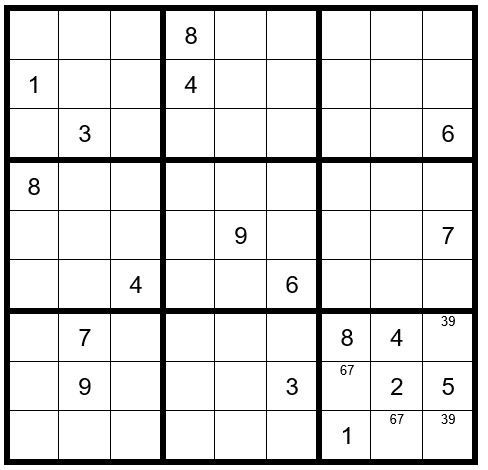
MARK UNSOLVED CELLS WITH OPTIONS THAT CANNOT EXIST IN THOSE CELLS …
In box 4 C1R6 & C3R4 are the only two cells that can have options 7 & 9, another obvious pair. Mark those cells with options 79.
In box 7 a 1 can exist only in C3R7 or C3R8; therefore, a 1 cannot exist as an option in C3R5. Pencil a small 1 in the bottom of C3R5 to indicate it cannot be a 1.
In box 2 a 3 & 6 can only exist in C5R1 or C5R2; therefore, mark those cells with options 36.
Now your grid should look like Example #47.3 below:
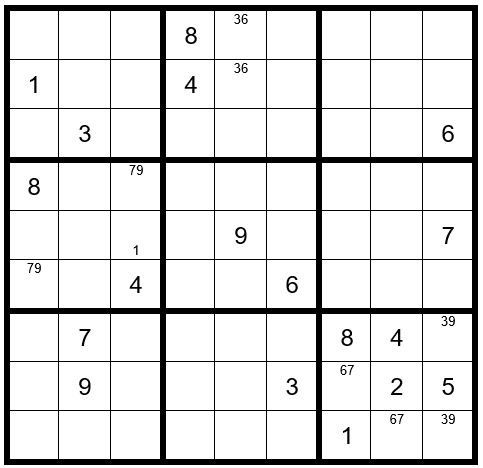
FILL IN THE OPTIONS FOR THE UNSOLVED CELLS …
Once you fill in the options for the unsolved cells, your grid should look like Example #47.4 below:

STEPS 1-8
There are no Step 1 clues. Moving to Step 2: Interaction & Turbos examine Box 4 carefully. We find the only unsolved cells with the option 3 are C1R5 & C3R5, creating an Interaction in that no other cells in row 5 can have a 3 as an option. We eliminate the 3 from C4R5, C7R5 & C8R5. Now your grid should look like Example #47.5 below:
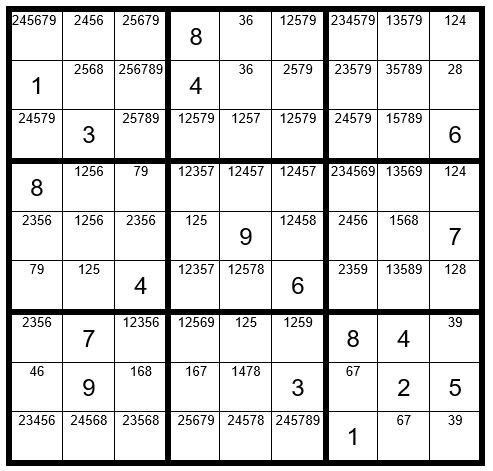
There are no other Step 1-5 clues. We will now move to Step 6: Dan’s Yes-No Challenge.
There are 3 circumstances that establish the potential for a Step 6 exercise:
- Look for just 2 unsolved cells in a box that contain the same option where these 2 cells are not in the same row or column.
- Look for just 2 unsolved cells in a column that contain the same option where these 2 cells are not in the same box.
- Look for just 2 unsolved cells in a row that contain the same option where these 2 cells are not in the same box.
We will start by searching the 1’s to see if there is a potential Step 6 clue, and then navigate through the 2-9’s.
In column 2 we find just 2 unsolved cells that contain the option 4 … C2R1 & C2R9. These cells are not in the same box, thereby qualifying as a candidate for a Step 6 exercise. The options in these cells are highlighted in yellow in Example #47.6 below:
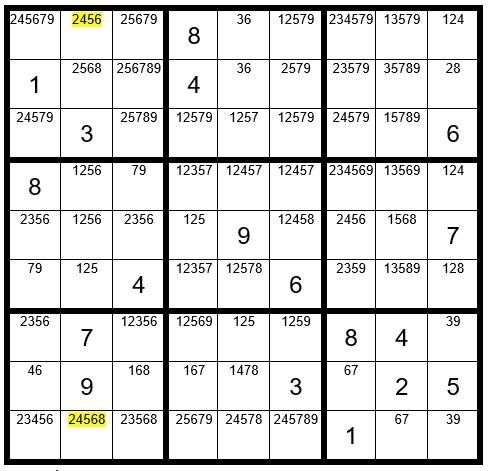
Do you agree that one of these two yellow cells in column 2 must be a 4? We will consider them as “driver cells” which “drive” the exercise.
Here is the logic. We will perform two exercises. First, we will assume C2R1 is the 4 and see which other cells cannot be a 4. Then we will assume C2R9 is the 4 and see which other cells cannot be a 4.
We will mark C2R1 with a “Y” and mark C2R9 with a lower case “y” to keep track of the exercise as per Example #47.7 below.
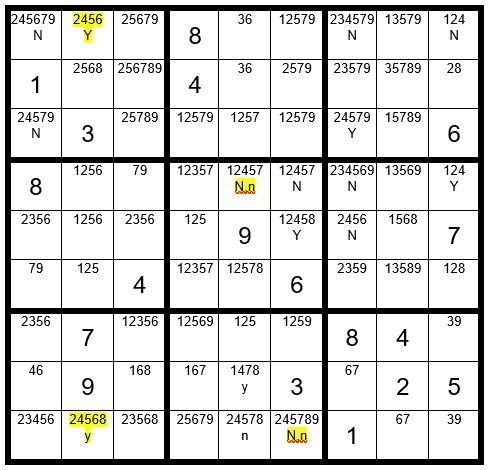
Example #47.7
We will start by assuming C2R1=4. Then, as marked above, C1R1, C1R3, C7R1 & C9R1 are not a 4 (marked with a “N”). Now the only cell in box 3 that can be a 4 is C7R3, so we will mark it as a “Y”. Then, C7R4=N. C7R5=N. C9R4=Y. C5R4=N. C6R4=N. C6R5=Y. C6R9=N.
Now we will assume C2R9=4 (y for yes). Then, C5R9 & C6R9=n. C5R8=y. C5R4=n.
We now see in Example #47.7 above that C5R4 & C6R9 have a “N,n” designation. What does that mean? Since we know one of the two yellow highlighted cells in column 2 must be a 4, the N,n cells cannot be a 4 regardless of which starter cell is a 4. We eliminate the 4 as an option from these cells.
Now your grid should look like Example #47.8 below:
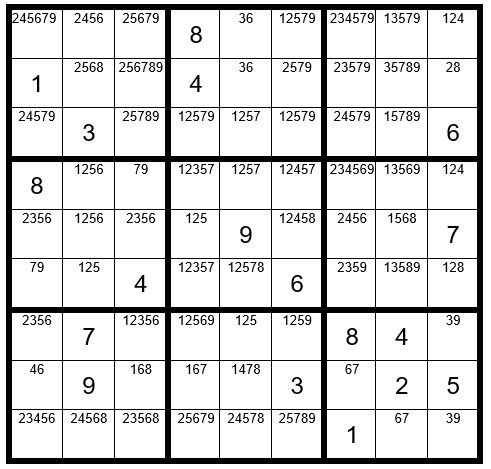
Example #47.8
We need further clues to solve the puzzle, so we will look for another Step 6 clue. In column 2 we find just 2 unsolved cells that contain the option 8 … C2R2 & C2R9. These cells are not in the same box, thereby qualifying as a candidate for a Step 6 exercise. The options in these cells are highlighted in yellow in Example #47.9 below:

Example #47.9
We will start by assuming C2R2=8 and marking that cell with a “Y” for yes. Then, as indicated above, C8R2 & C9R2 =N. C8R3=Y. C8R5 & C8R6=N. C9R6=Y. C5R6=N. C6R5=Y. C6R9=N.
Now we will assume C2R9=8 (y for yes). Then, C5R9 & C6R9=n. C5R8=y. C5R6=n. C6R5=y. C8R5=n.
We now see in Example #47.9 above that C5R6, C6R9 & C8R5 have a “N,n” designation. We eliminate the 8 as an option from these cells. C6R5 has a Y,y designation. So, C6R5=8.
Now your grid should look like Example #47.10 below:
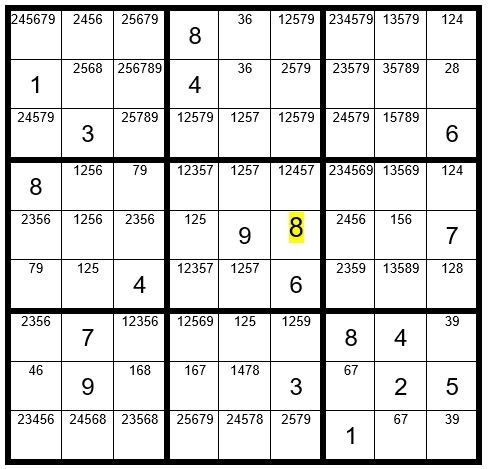
Example #47.10
It now follows that C6R4=4. C7R5=4. C9R1=4. C1R3=4. C1R8=6. C7R8=7. C8R9=6. C4R7=6. C4R8=1, and so forth.
From this point the puzzle is easily solved. Your final grid should now look like Example #47.11 below:
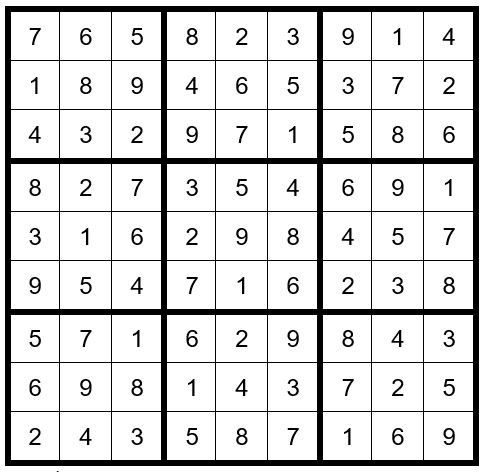
Example #47.11
Wishing you and yours a very happy holiday season.
May the gentle winds of Sudoku be at your back,
Dan LeKander
Now the cold weather is here, we ask the question :Do you tackle a Sudoku beside your fireplace, on the bus going to work or anywhere you have the chance? Write and tell us where? OK.
Editor’s note:
In January 2016, we published a final article in his series – but many of us enjoy using “Dan’s Steps,” so when he asked if we would like a puzzle to solve every month … this editor said an enthusiastic… Yes, please! Now we are several years later and on Puzzle #47!
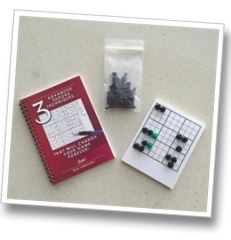
I suggest you purchase Dan’s book as a Christmas gift: “3 Advanced Sudoku Techniques, That Will Change Your Game Forever!”
The book is available online, amazon.com and on ebay.com.
Purchase of a book includes a 50-page blank grid pad, 33 black and two green tokens, to assist with Step 6.…
Most importantly, I ask that you leave comments on any part of his series and throughout the year. Remember when your teacher said – no such thing as a silly question – as we can all learn together.
As always, I want to thank Dan…and his proofreader… Peggy! I am hoping you will enjoy our Sudoku and at the same time join me in thanking Dan - Bravo and Merry Christmas to you two.


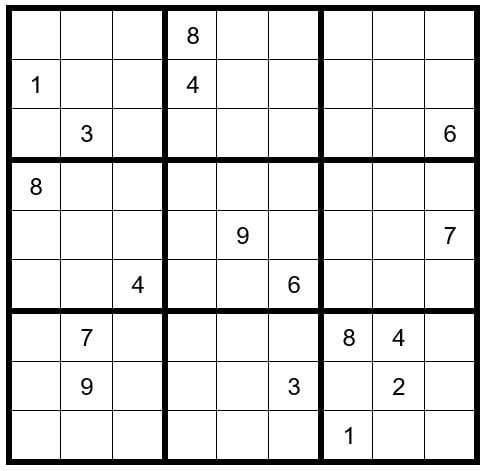


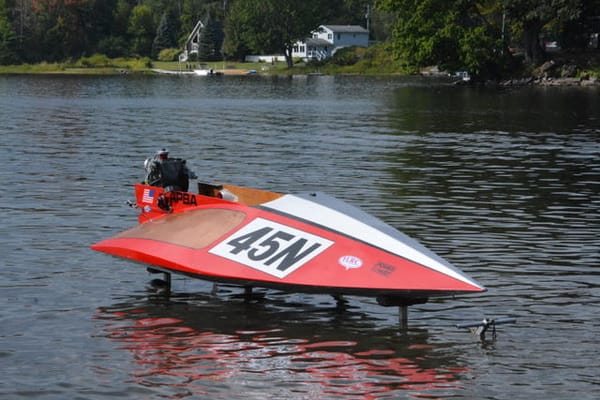
Please click here if you are unable to post your comment.